
Theoretical Framework and Overview
JEAN RHYS: WOMEN, MELANCHOLIA AND NOSTALGIA – PART 2
Cathleen Maslen
From Cathleen Maslen, ‘Too Late for Truth: Women, Melancholia and Nostalgia in Jean Rhys’ in her book Ferocious Things: Jean Rhys and the Politics of Women’s Melancholia
(Newcastle upon Tyne: Cambridge Scholars Publishing, 2009) pp. 16-26
THIS IS PART 2 OF THE ESSAY. READ PART 1 FIRST.

Jean Rhys
III. SPLIT SELVES AND LOST THINGS: MELANCHOLIA IN PSYCHOANALYSIS
It should be clear at this point that by invoking the term ‘melancholia’ in this study of Rhys, I am not just referring to the self-evident sadness of the protagonists. Rather, I refer to the mournful, traumatized Rhysian protagonist’s appropriation of melancholia as a psycho-cultural discourse of identity and consolidation. To elaborate, melancholia in Rhys’s work superficially signifies as a means of stabilizing imperilled feminine identity by foregrounding one’s very displacement and alienation, often through public or at least privately self-conscious gestures of lamentation. I will now attempt to elucidate some intersections between melancholia as a cultural script of selfhood and the depressive psychology as articulated by psychoanalytic discourse. The melancholic subject of psychoanalysis is convinced that he or she has suffered a catastrophic but not easily specified loss, a loss of ‘something’ or, to borrow Julia Kristeva’s rhetoric, the loss of the ‘Thing’. In Black Sun: Depression and Melancholia, Kristeva writes: Let me posit the ‘Thing’ as the real that does not lend itself to signification, the centre of attraction and repulsion, seat of the sexuality from which the object of desire will become separated. For all its vagueness and inaccessibility to conscious analysis, the melancholic sensibility always positions this lost Thing as absolutely authentic and irreplaceable. In Kristeva’s work, and in the theory of melancholia more generally, this Thing is usually associated with the lost mother, or, more specifically, with the bygone bliss of the mother-infant dyad, which psychoanalysis from Freud onwards has designated as the phase of ‘primary narcissism’ in the developing individual, For now, however, I will restrict myself to discussing how this understanding of melancholia as an identification with obscure loss informs both psychoanalytic and cultural narratives of melancholia.
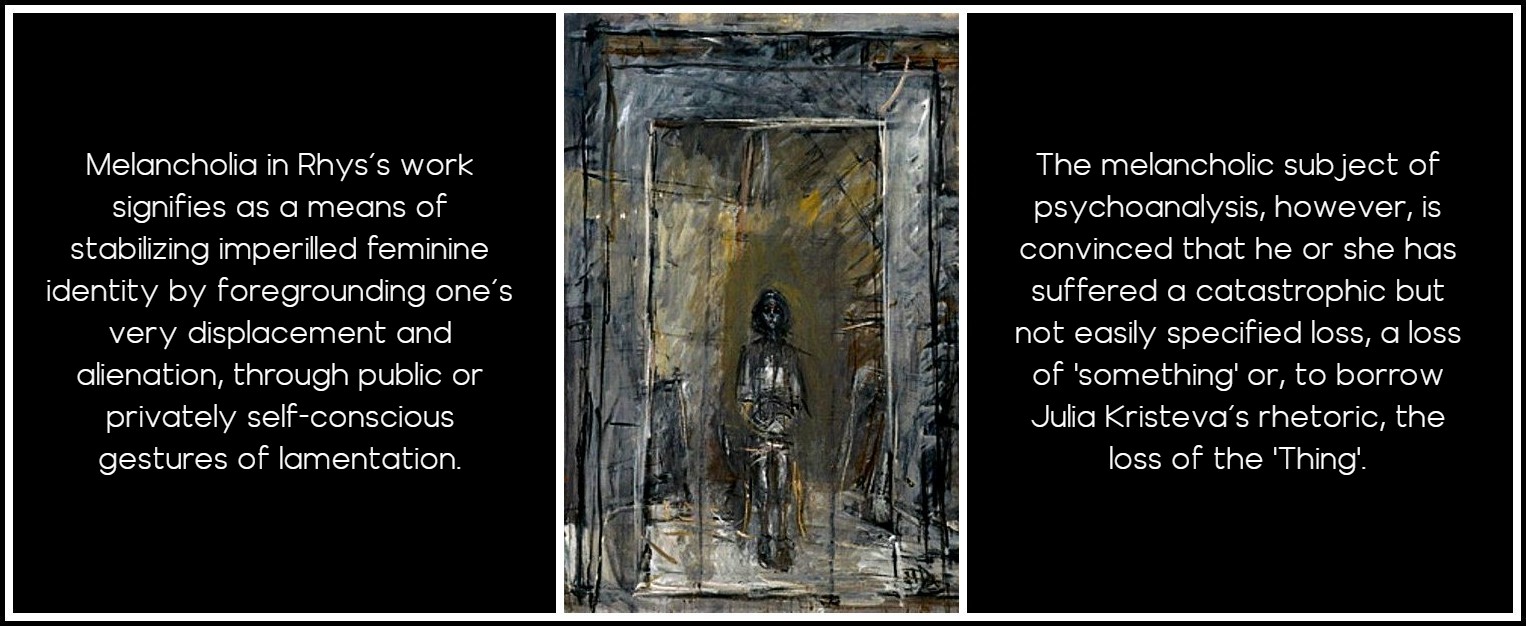
Giacometti, Annette assise, 1954
Theorists throughout the history of psychoanalysis have interpreted melancholic or depressive affects as moods generated by an ‘identity crisis’ in the unconscious. The melancholic sensibility, understood in this therapeutic context, traditionally perplexes the clinical observer in that the depressed subject can simultaneously evince a nihilistic lack of affect or ‘feeling’ and an excess of feeling or mood, albeit a mood of extreme negativity: that is, self-deprecation and self-reproach. Freud’s seminal paper, ‘Mourning and Melancholia,’ emphasizes both the ‘cessation of interest in the outside world’ and the ‘extraordinary diminution in the melancholic’s self-regard.’ It seems as if the melancholic’s ‘loss of interest’ in the world is connected with an escalation of interest in the theme of personalized, interior dilapidation—that is, the melancholic’s impoverishment of interest in other people may bespeak an overinvestment, psychically speaking, in an alternative spectacle: one’s own unique, personal ‘worthlessness’. As Freud writes, ‘the melancholic reproaches himself, vilifies himself and expects to be cast out and punished.’ This melancholic is no silent sufferer and he does not anticipate that his failings might be beneath the notice of other people, despite his apparent loss of interest in the outside world. Thus, Freud draws our attention to the point that the melancholic’s apparent self-hatred is also a form of self-importance.

Giacometti, Figure grise, 1957
Freud also mentions less frequently observed melancholic delusions, which support his argument concerning the perverse self-interest or narcissism of the melancholic: the latter fantasises about ‘bodily infirmity, ugliness or weakness, or social inferiority,’ and in particular ‘fears and asseverations of becoming poor.’ One striking implication of this catalogue of delusions in Freud’s essay is that people who suffer psychologically because they are genuinely socially inferior or poor are distinct from the more privileged melancholic subject. In this respect, ‘Mourning and Melancholia’ exemplifies the way in which, as Marie Maclean puts it, ‘psychoanalysis is itself conditioned by ideologies of class, of gender and of religion. The danger is always that the analyst will assume the universality of their own experience.’ Consciously or otherwise, Freud emphasises his own privileges and those of his patients in his essay: he is a middle-class doctor treating affluent melancholics who principally fantasise about social disempowerment. The reinforcement of cultural hegemony in the text of ‘Mourning and Melancholia’ is also apparent in an earlier part of the essay, when Freud describes how melancholic women imagine that they are worthless, and then adds, in an incongruous aside, that ‘of the woman who is really worthless, we too should have nothing good to say.’ In no uncertain terms, then, Freud reserves his humane approach to mental illness for ‘worthy’ depressive women, presumably those who uphold an appropriate, prescribed social and sexual role.
1 – Marie Maclean, The Name of the Mother: Writing Illegitimacy (Routledge, 1994) 36
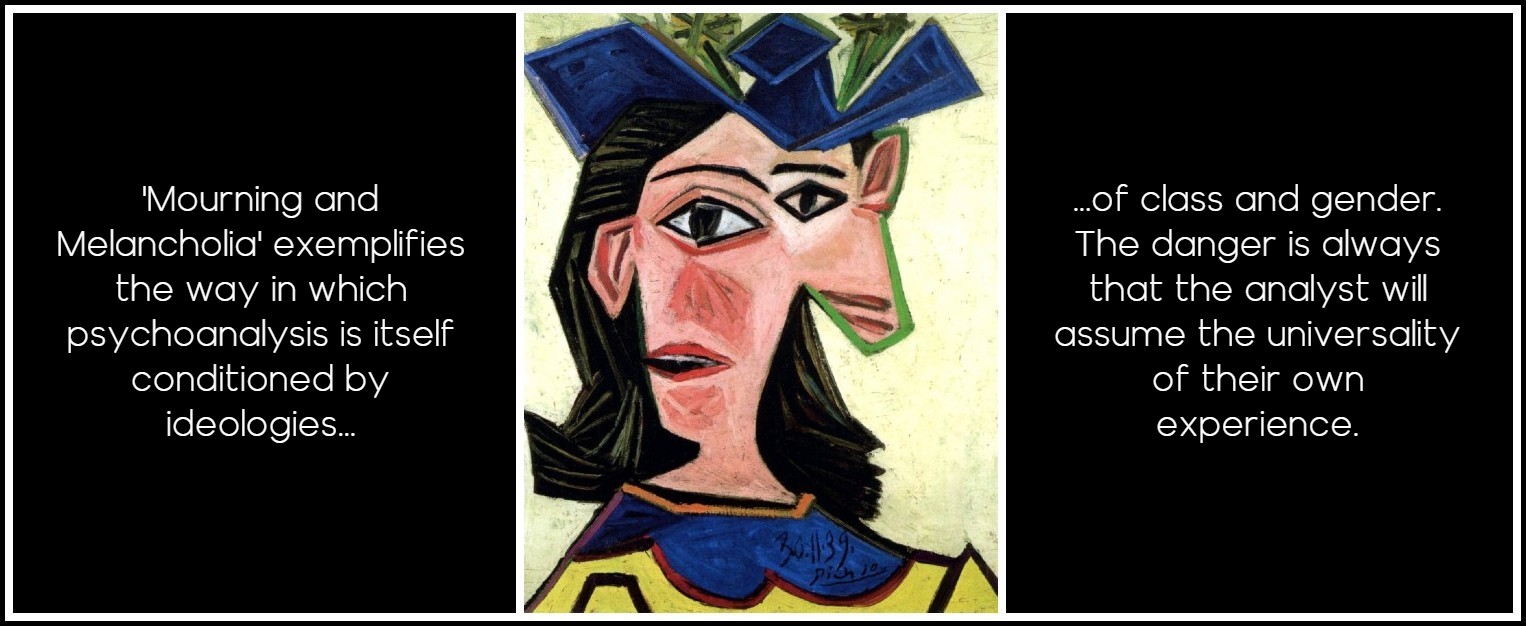
Picasso, Bust of a Woman with Hat (Dora), 1939
If we identify Rhys’s characters as psychologically melancholic in accordance with the affects and psychic processes that Freud outlines in this essay, we must also admit that their fears of ‘becoming poor,’ or socially ‘inferior,’ are hardly delusional but quite appropriate given their always-imperilled socio-economic security. From Freud’s bourgeois point of view, Rhys’s women might also be deemed ‘worthless’ in that they are sexually available (although as a rule Rhys’s women take little pleasure from their sexual transgressions, which are guided by masculinist heterosexual scripts of ‘kept women’ and ‘mistresses’). In connection with this point, it should also be admitted that Rhys’s protagonists’ preoccupation with their appearance (delusions of ‘ugliness’) suggests not merely melancholic self-absorption but also a more pragmatic anxiety regarding their viability as sexual commodities. Thus, the socio-cultural context of Rhys’s women’s apparently melancholic or neurotic symptoms complicates Freud’s simplistic and class-blind account of feminine melancholia.
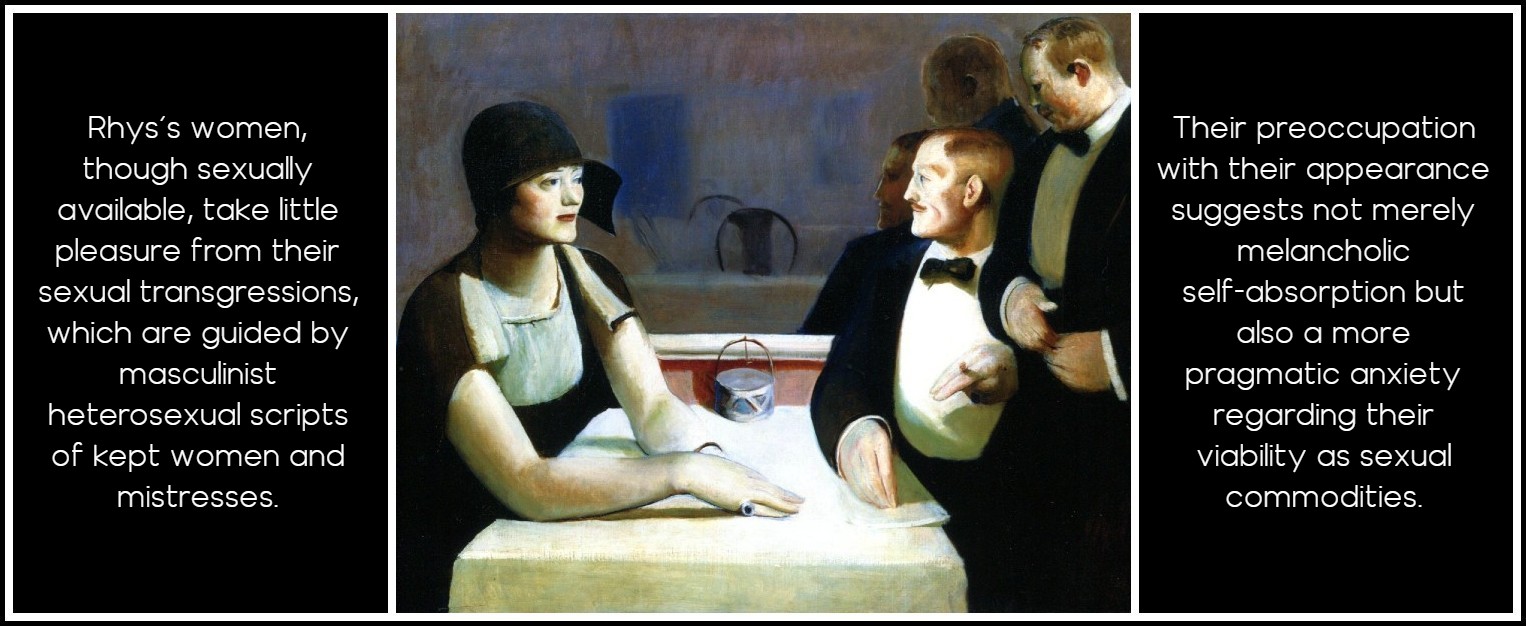
Guy Pène du Bois, Mr. and Mrs. Chester Dale Dine Out, 1924
Another striking, ironic resonance might be discerned between Freud’s observations regarding melancholic self-splitting and the non-integrated, dissonant identities of Rhys’s protagonists. Freud’s aetiology of melancholia, still highly influential in psychoanalytic theory, observes a rather grandiose self-hatred competing with apathy, emptiness and numbness, and concludes that this particular constellation of affect results from the afflicted person’s unconscious effort to identify with (and thus, in a self-destructive way, reclaim or incorporate) a mysterious ‘lost thing’. In Freudian analysis, this lost thing is likely to masquerade as a specific love object: An object-choice had at one time existed; then, owing to a real or slight disappointment coming from this loved person, the object-relationship was shattered. The free libido was not displaced onto another object, it was withdrawn into the ego. There, it served to establish an identification of the ego with the abandoned object. Thus the shadow of the object fell upon the ego, and the latter could henceforth be judged by a special agency, as though it were an object, the abandoned object. Freud’s description of melancholic identification is surprisingly poetic. The psyche is imagined as a distinctive space, into which objects are introjected or expelled. In melancholia, it is also a haunted space, darkened by the ghost or ‘shadow of the object’ that is no longer accessible. This rather gothic image becomes almost ghoulish in the psychoanalytic theory of Nicholas Abraham and Maria Torok, who suggest that the fundamental melancholic desire is to eat the lost object: in order not to have to ‘swallow’ a loss, we fantasize swallowing that which has been lost, as if it were some kind of thing.
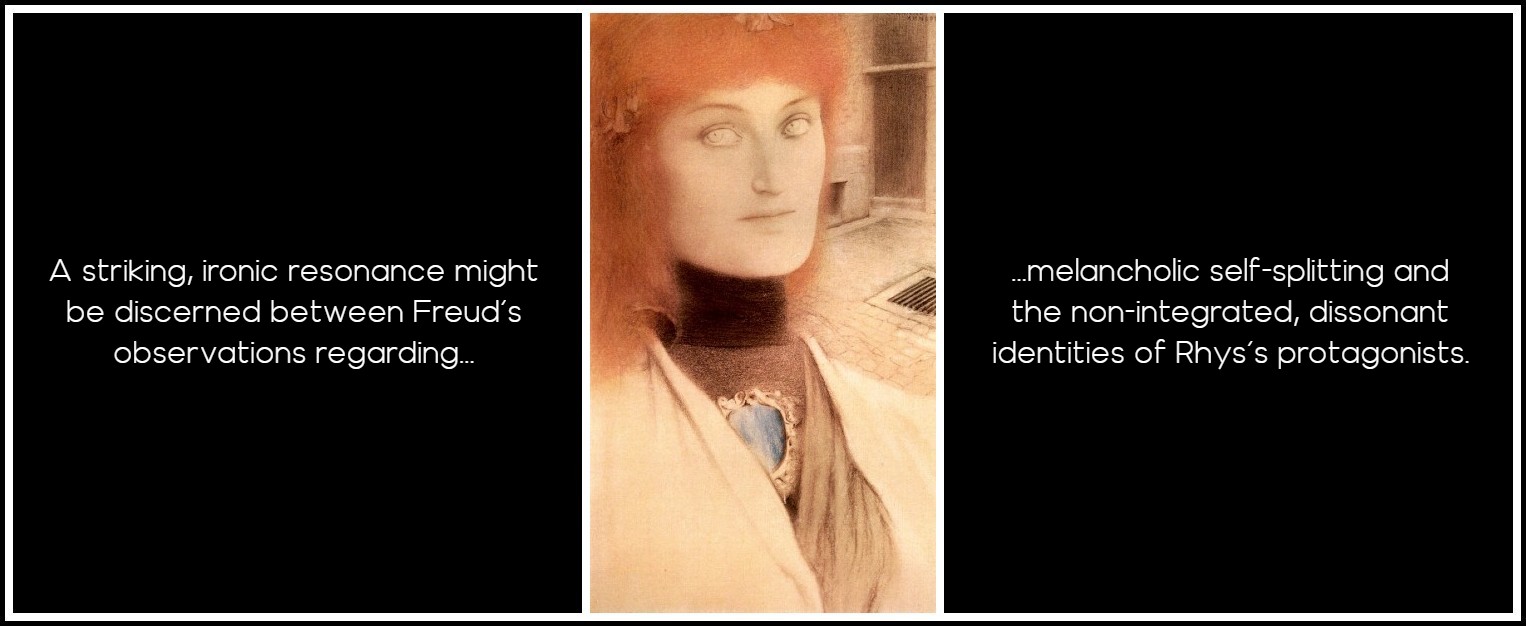
Fernand Khnopff, Who shall deliver me?, 1891
It should be emphasized that for Abraham and Torok, ‘incorporation’ is the opposite of ‘introjection.’ Incorporation, they argue, is a fantasy idiosyncratic to the melancholic psyche, through which lost objects are delusionally retained (that is, ‘swallowed’ on the level of fantasy). It connotes the melancholic fantasy of resisting loss through identification with loss. Introjection, on the other hand, is understood as a healthy process, through which loss is admitted into consciousness and its pain displaced by language and representation. Abraham and Torok’s emphasis upon the simultaneous objectification and refusal of loss is useful in approaching Rhys’s themes of melancholia, as is Freud’s image of the ‘shadow of the object’ haunting the melancholic subject. Nonetheless, these elegiac, striking narratives of the melancholic psyche seem to neutralize the cultural, historical and political differences between individual melancholic subjects, or even to restrict the melancholic identity to a particularly privileged subject whose sadness, convictions of being haunted by loss, wishing to ‘swallow’ loss and so forth, can only be understood in psychological terms. But what of the melancholic subject who is constrained, by virtue of a less privileged social and cultural positioning, to incorporate loss and forfeit representation? Or, to put it differently, what of the person who is not situated in culture as a ‘space’—that is, as a privileged transparent subjectivity—but rather as ‘some kind of thing’ (to borrow Abraham and Torok’s phrase)?

Fernand Khnopff, Study of a Woman, 1895
Rhys depicts this painful collision between melancholic affect and objectified, silenced social positioning. For example, in Voyage in the Dark, Anna Morgan’s reaction to her lover’s rejection reads like a first-person narrativization of the melancholic process of self-splitting and incorporation as described by Freud. After Walter Jeffries announces he no longer loves her, she objectifies herself, visualising her body from without, as a dead body: I was thinking, ‘You don’t know anything about me. I don’t care anymore.’ And I didn’t care anymore. It was like letting go and falling back into water and seeing yourself grinning up through the water, your face like a mask, and seeing the bubbles coming up as if you were trying to speak from under the water. And how do you know what it’s like trying to speak from underwater when you are drowned? According to the Freudian rubric, Anna has substituted Walter’s point of view for her own, at her own expense, rather than give up Walter altogether. That is, she ‘abandons’ herself, as Walter has abandoned her. Importantly, this incorporation is inflected by Anna’s status as a sexual object, in that her envisioning of herself as an object, ‘the forsaken object’ (as Freud puts it) is not delusional but has its basis in Anna’s social and cultural reality. Anna is objectified, silenced and abandoned by Walter Jeffries, her lovers after Walter Jeffries, and her stepmother Hester, who is appalled by Anna’s sexual identity as a chorus girl and a ‘kept woman.’ Rhys’s emphasis upon the retardation of Anna’s speech (‘like trying to speak from underwater’), a well-known melancholic symptom, implies that speechlessness might also be symptomatic of a wider sexual and colonialist culture of objectification and othering.
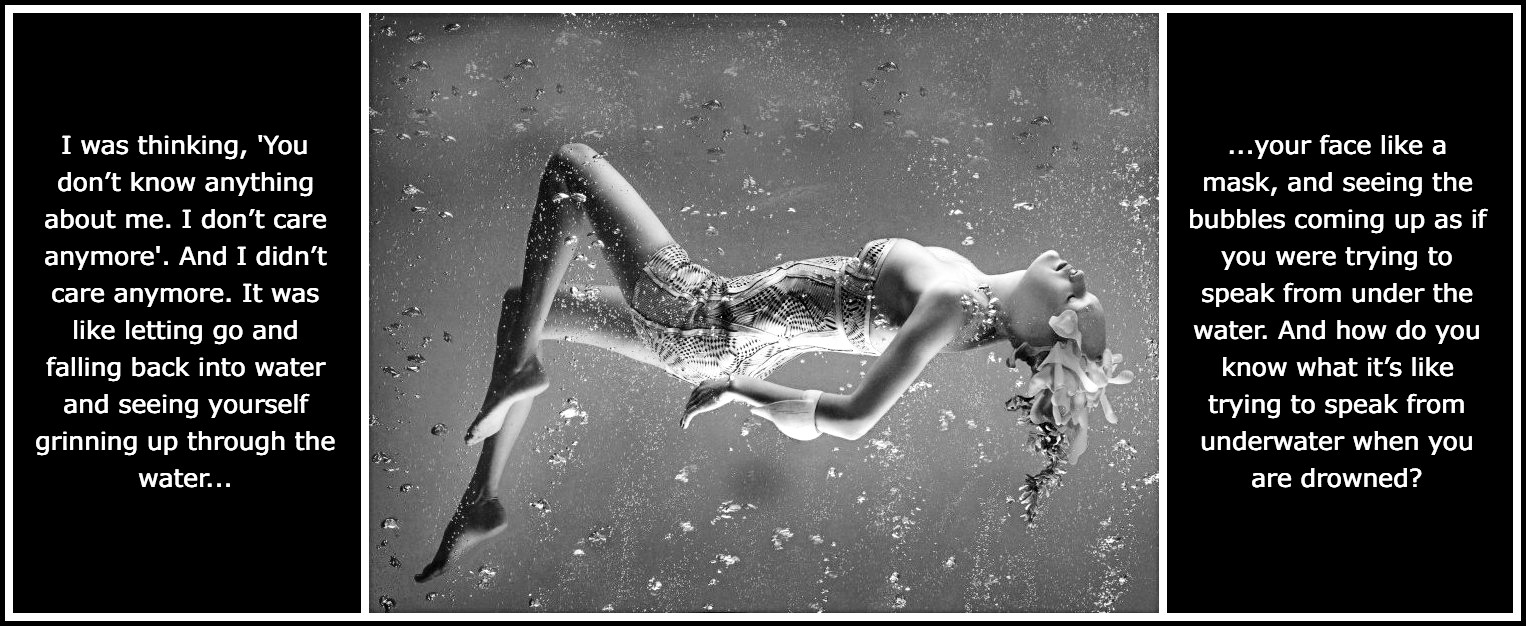
Sølve Sundsbø, ‘The Girl from Atlantis’, Vogue Nippon (May 2010)
Such disorientating subjective and identificatory fractures are experienced by all of Rhys’s characters. Their sense of loss and incompleteness, while often understandable in terms of their personal histories and social position, nonetheless reads as melancholically obscure, strangely anterior and irrelevant to their ‘actual’ losses. Even the articulate Sasha Jansen, in Good Morning, Midnight, does not attempt to analyze her melancholia, but merely observes her psychic inconsistency and dissonance: Who is this crying? The same one who laughed on the landing, kissed him and was happy. This is me, this is myself, who is crying. The other—how do I know who the other is? The question of the identity of ‘the other’ recurs throughout Rhys’s work. It should be noted that very often, as with Sasha, Rhys’s protagonists are vexed by extremely unstable identifications and desires, and self-consciously understand themselves as ill-defined personalities, existing in unhappy subjection to paranoid, confused, or surreal apprehensions. However, while the alienation of these women from stable, normative identity and perceptiveness is often acknowledged by the women themselves, they seem hard pressed to analyze or resist (let alone resolve) the problem. Indeed, for all the suffering that such vagaries of identification create, it is far from certain that Rhys’s characters want to ‘normalize’ themselves. Julia Martin, in After Leaving Mr Mackenzie, is at once terrified and elated when she hallucinates a painted woman coming to life and announcing: ‘I am more real than you.’ Julia is not merely impressed by the surreality of a picture of a woman addressing her, but also by the way in which this picture, even as it steals her identity, also alludes to the existence of a ‘true’ but hidden Julia: ‘I knew that if I could get to the end of what I was feeling,’ Julia says of her emotions after this remarkable incident, ‘it would be the truth about myself’. However, this ‘truth about herself,’ Julia’s ultimate melancholic lost thing, always eludes her.
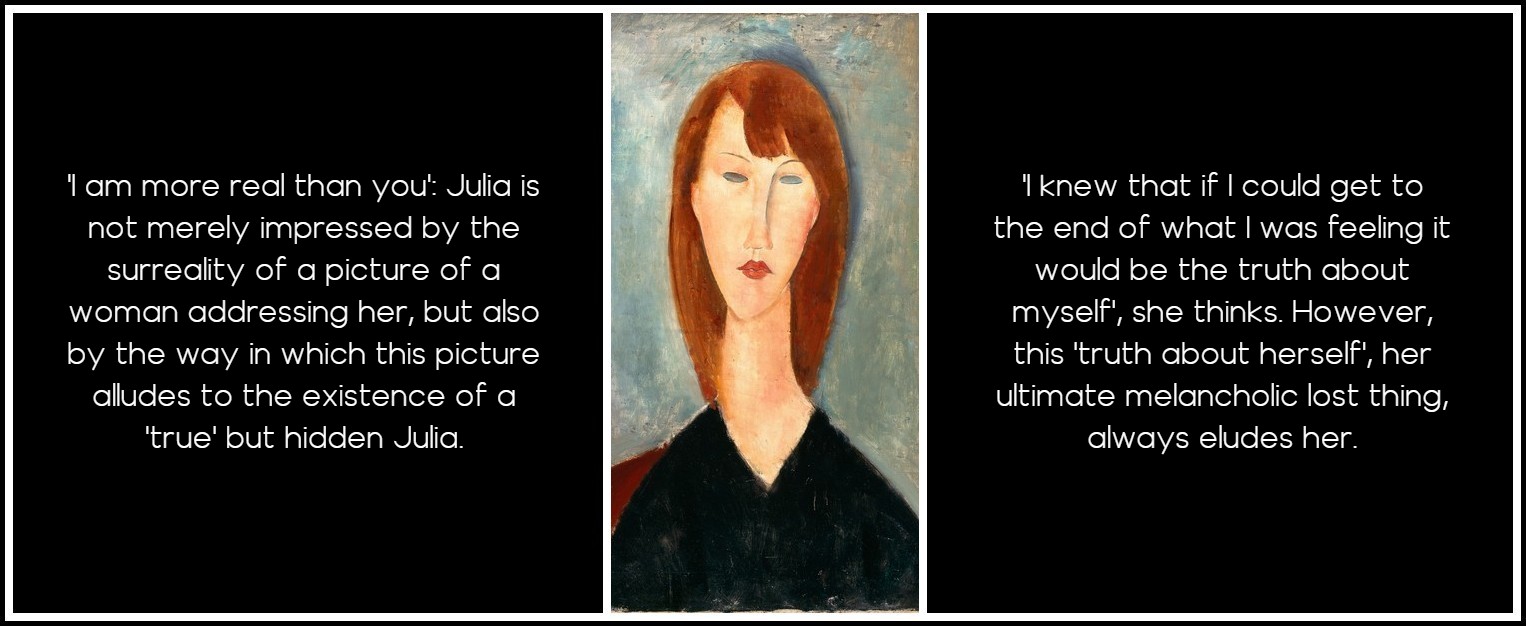
Modigliani, Portrait of a Woman, 1918
Anna’s disembodiment, Sasha’s multiple selves and Julia’s sense that as a person she has no reality all seem to resonate with Freud’s description of melancholic processes of incorporation and self-splitting. Nonetheless, I suggest that it would be misguided simply to interpret these psychic peculiarities as straightforwardly symptomatic of melancholia. To be sure, Rhys’s protagonists are depressed and afflicted by crises of identity, but Rhys always emphasises how class positionality, Eurocentric cultural values, and in particular the politics of heterosexuality guide the self-objectifying perspectives of these women. I privilege the gender problem with respect to the self-objectification of Rhys’s characters in particular because Rhys’s work specifically contemplates ways in which women perniciously incorporate an ambiguously predatory-paternal male sexual gaze. Mary Lou Emery’s comment that ‘Julia’s perspective has become that of the internalized masculine surveyor’ is applicable to all of Rhys’s protagonists.1 While the hyper-sexualization which Rhys’s characters experience nearly always intersects with Eurocentric fetishes (the erotic ‘exoticism’ of the white Creoles Anna and Antoinette), or even capitalist fetishes (as when Horsfield, in After Leaving Mr Mackenzie, is aroused by the very act of giving Julia money), these objectifying eroticisms of race and capital need at least the guise of heterosexual desire and anxiety if they are to signify as ‘natural’ urges, as opposed to gestures made in the service of imperialism and class hegemony. In short, while melancholic ‘illness’ in Rhys’s novels is often prompted by a scrutinizing, objectifying paternalist heterosexuality, this oppressive masculine surveillance, overtly misogynist and sexually exploitative, may covertly instantiate strategies of imperialist and capitalist ascendency.
1 – Mary Lou Emery, Jean Rhys at ‘Worlds End’: Novels of Colonial and Sexual Exile (Austin: University of Texas Press, 1990) 141
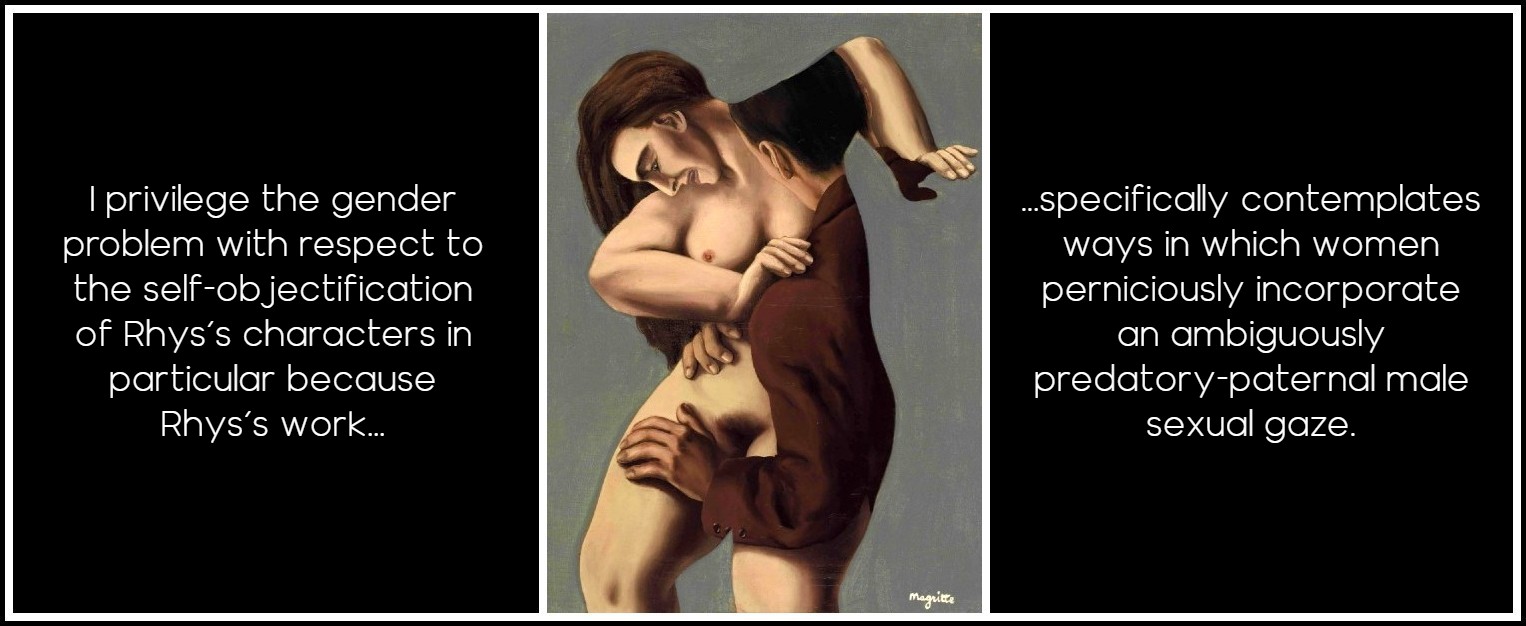
Magritte, Les jours gigantesques, 1928
IV. NOSTALGIA AND THE MOTHER
How can the desires and identifications of Rhys’s protagonists be understood as expressive of a dominant, ‘masculinist’ melancholia? In what sense do they invest in the grandiose Western narrative of the homo melancholicus? The answer to this question is relatively simple: the identities to which Rhys’s women aspire, and the desires that haunt them, are nostalgic, sometimes quite subtly, and sometimes very obviously (as in Wide Sargasso Sea and Voyage in the Dark). These women crave to recuperate a certain authenticity and origin as alienated, marginal women. They cannot, however, gesture towards standard narratives of cultural ‘recovery’ and origin, precisely because of marginalization—that is, they are perceived as subjects exterior to fields of recognizable, legitimate culture and origin. Indeed, Rhys’s protagonists are not merely difficult to situate in terms of conventional sexual, ethnic and geopolitical discourses: they also resist the idioms of familiar marginality, as it were. They cannot, for example, straightforwardly identify with either European or Caribbean women. It might seem unsurprising, from the reader’s point of view, that Rhys’s culturally amorphous, exclusively ‘othered’ women often evince a deep psychological wish for cultural origin and authenticity. However, it is the repeated frustration of this regressive (if sympathetic) desire which creates the possibility of novel, unpredictable transgression (as opposed to easy, tokenistic identification) in cultural contexts of reflexive oppression and silencings.

Edvard Munch, Birgit Prestøe – Portrait Study, 1925
At this point I want to explain precisely why I believe that nostalgic fantasy and desire contravene constructive feminist thinking. In order to address the masculinist politics of nostalgia and its implications for reading Rhys, it is first necessary to elucidate the connections between nostalgia and the psychoanalytic and cultural narratives of the lost space and time of ‘authenticity.’ This phantasmic authenticity is usually gendered as feminine-maternal, and provides significant psychological as well as ideological grounds for misogynist discourse. Carefully reading Freud’s ‘Mourning and Melancholia,’ we can see how it is the intractably nostalgic tendency of the melancholic’s psychic response to loss, his fixation upon the past, rather than a particular lost person or thing, that enables Freud to characterize him as ‘pathological.’ In healthy grief, a subject similarly traumatized by the loss of a loved person performs what Freud calls ‘the work of mourning’ and reconstructs his or her idea of the now inaccessible person, so that this idea may ‘respect reality.’ In other words, healthy mourning ultimately respects conventional time, and indeed allows itself to be ‘cured’ by time: ‘we rest assured that after a lapse of time, grief will be overcome,’ as Freud writes.

Photo: Alexandra Marta, Unsplash
For the melancholic, however, the passage of time (and by implication the eclipsing of loss or trauma that time achieves) is the nemesis of his or her identity, and must be resisted at all costs, even to the point of suicide. Thus, in Freudian and post-Freudian theories of melancholia, the mystique and significance of melancholia ultimately reside in its slippage from seeking a thing to seeking a time: that is, its nostalgic tendency. Even Freud, who begins his essay confidently positing that the melancholic has been ‘disappointed’ by a particular person, admits that knowledge of this particular trigger for melancholic illness is of little therapeutic value: ‘He knows who he has lost not what he has lost in him. This would suggest that melancholia is in some way related to an object-loss which is withdrawn from consciousness, in contradistinction to mourning, in which there is nothing about the loss which is unconscious.’
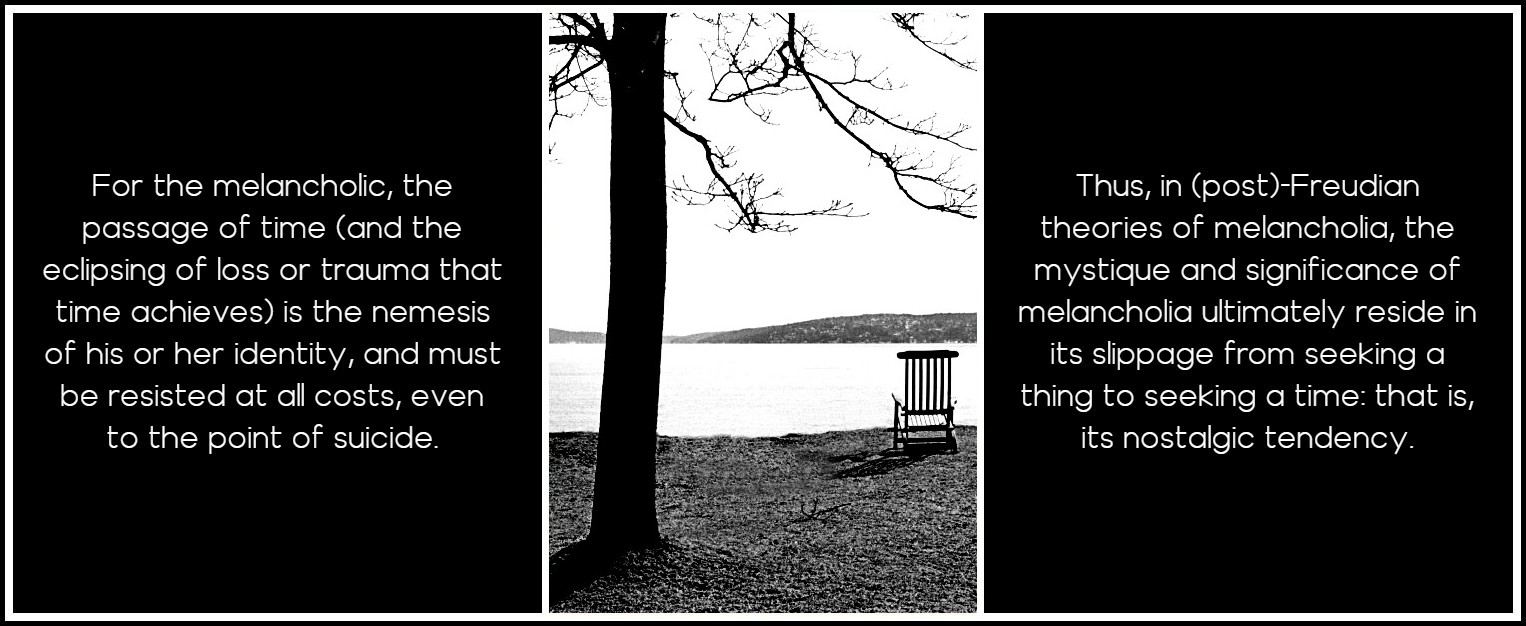
Photo: Lawrence Krowdeed, Unsplash
In her book Black Sun: Depression and Melancholia, Julia Kristeva argues that this ‘object loss that is withdrawn from consciousness’ is the mother, or rather the mother remembered as the pre-Oedipal object of narcissistic infantile love. She writes: ‘Freudian theory detects everywhere the same impossible mourning for the maternal object.’ It seems critical to recognize that what is at stake is not necessarily the melancholic’s biological mother. Indeed, as I have already suggested, the nostalgic melancholic seeks something much less readily identified, and perhaps much more ambitious, than the castigation of his or her mother. To speculate, it might be the case that the melancholic is preoccupied with the loss of an idealized maternal time—perhaps better characterized as an imagined timelessness, an archaic, infantile utopia free from quotidian anxieties of identity, self-consciousness and mortality.
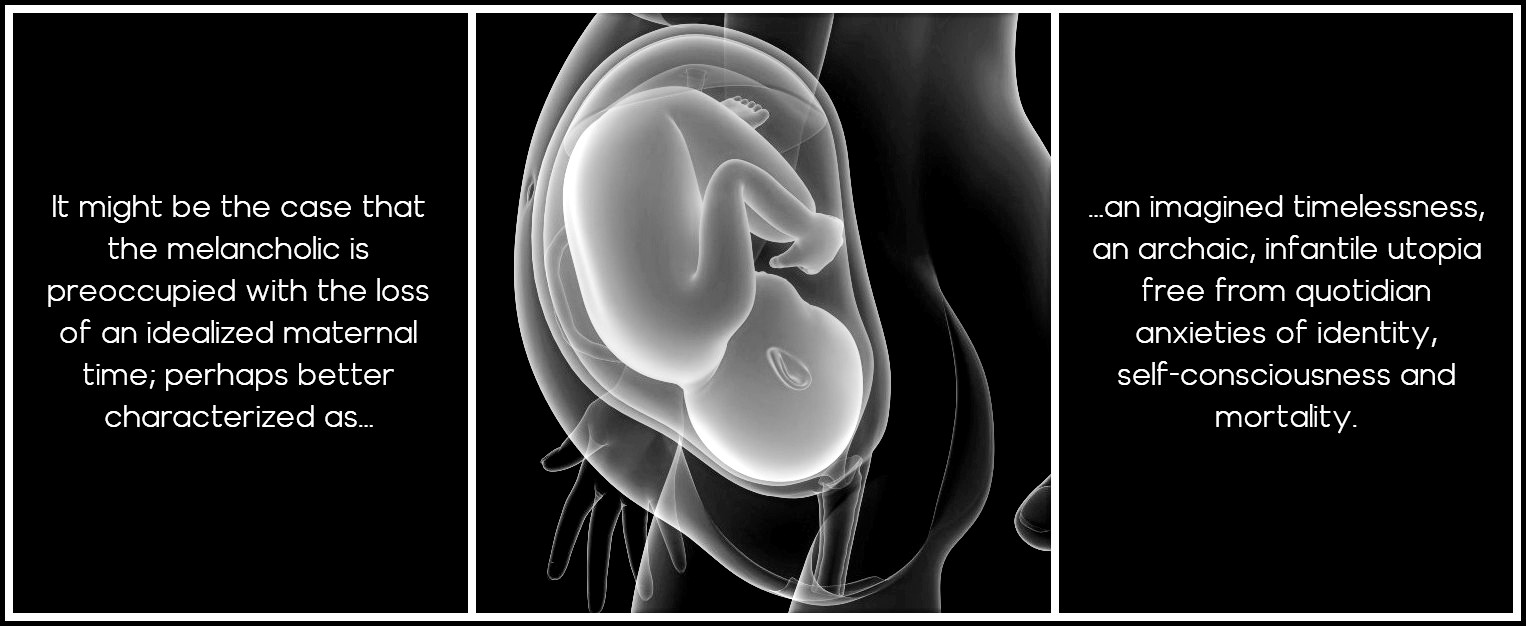
Photo: Getty Images for Unsplash
Nonetheless, the melancholic’s mother traditionally functions, particularly in art and literature, as his or her specifiable object of disappointment and hatred. Putting aside the melancholic tendency to demonize the mother in particular, this nostalgia for the pre-history of the subject, before Oedipal interdiction and the rupture of the mother-infant dyad, is suspect from a feminist point of view because it does not remember, but rather constructs, a stereotypical mother-phantasm. The process of mourning or ‘remembering’ a lost pre-Oedipal mother requires a discrete subject capable of mourning and remembering. The problem with psychoanalytic theories of melancholia that focus on lost maternal utopias, such as Kristeva’s work, is that experiencing infanthood as ‘utopian’ must be an oxymoronic proposition from the psychoanalytic perspective, since this blissful pre-Oedipal infant is allegedly unconsolidated or, in Lacanian terms, ‘undifferentiated’, and therefore unaware of his bliss.
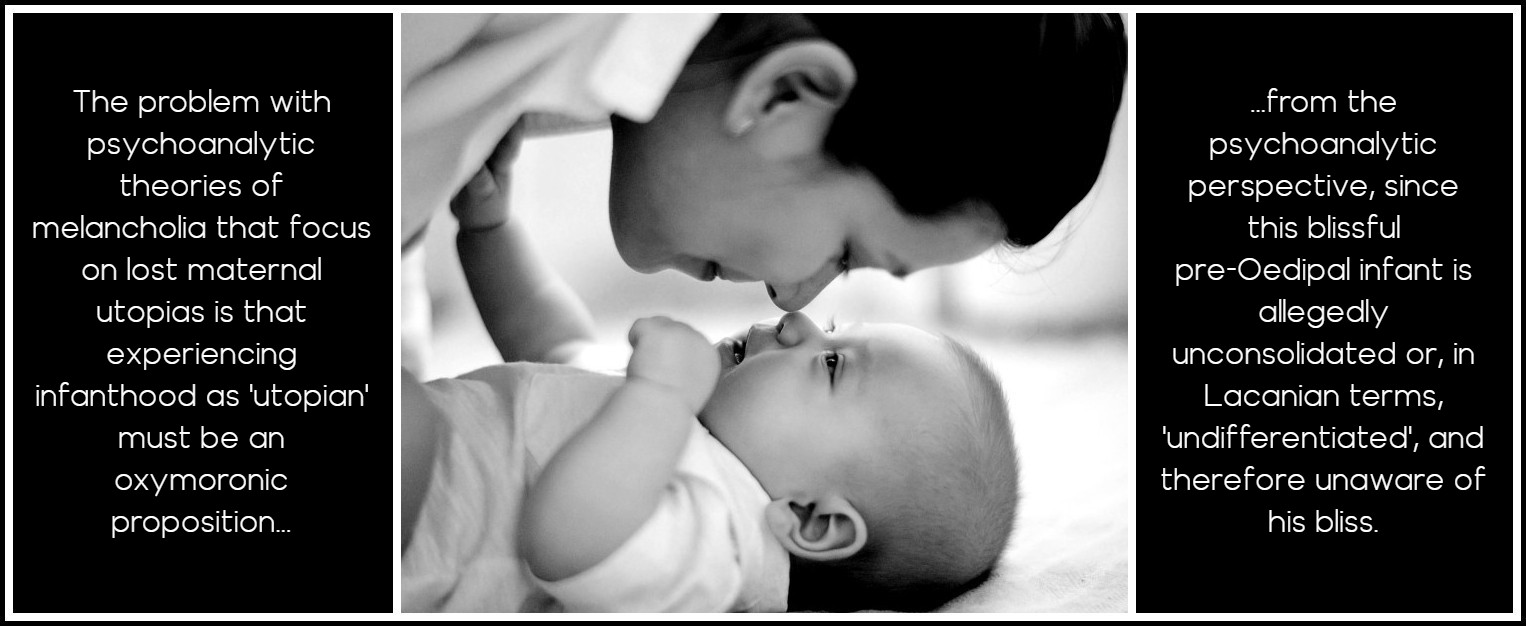
Photo: Ana Tablas, Unsplash
Indeed, Lacanian psychoanalysis suggests the mother-child fusion must be lost, overtaken by the paternalist mediations of language, if the subject who allegedly ‘misses’ his original dyadic bliss is to exist per se. Or, as Schiesari puts it, the melancholic subject who mourns this maternal pre-history as the scene of his ‘authentic’ self mourns ‘a self that never was’. It would seem, then, that the true theme of nostalgic desire is not ‘authenticity’ and its passing, but rather a cultural story of bygone authenticity and corrupted ‘true’ identity that uses misogynist rhetoric to characterize loss and corruption as distinctly feminine emanations, when not directly pointing the finger at women and mothers in particular. In Voyage in the Dark and Wide Sargasso Sea Rhys intimates the dubiousness of this misogynist nostalgia by subversively rehearsing it from a feminine point of view, demonstrating how nostalgic obsession with recuperating the presumed fulfilment and completeness of an archaic maternalist era might, especially for women, ironically culminate in actual self-annihilation.

Photo: Getty Images for Unsplash
To elaborate, Rhys’s inscriptions of nostalgia, especially in After Leaving Mr Mackenzie, Voyage in the Dark and Wide Sargasso Sea, are remarkably sensitive to the paradoxes and ironies of feminine expressions of nostalgia for the mother, inasmuch as this desire tends to preclude maternal subjectivity, and by implication the subjectivity of the nostalgic woman herself. The self-objectification that characterizes the perspectives of Rhys’s protagonists might signal an unconscious protest against the nostalgic Oedipal script of femaleness and maternity. As Madelon Sprengnether notes, ‘lost origins cannot exist, except at the cost of the subjectivity of the mother herself.’ Sprengnether elaborates upon the absurdity of the idea of ‘mother-infant symbiosis’ from the mother’s point of view: ‘a mother can only act as a mother if she perceives herself as such, as separate and different from her infant. A mother who felt in every way like an infant would be worse than useless as a caretaker.’1
1 – Madelon Sprengnether, The Spectral Mother (Ithaca: Cornell University Press)
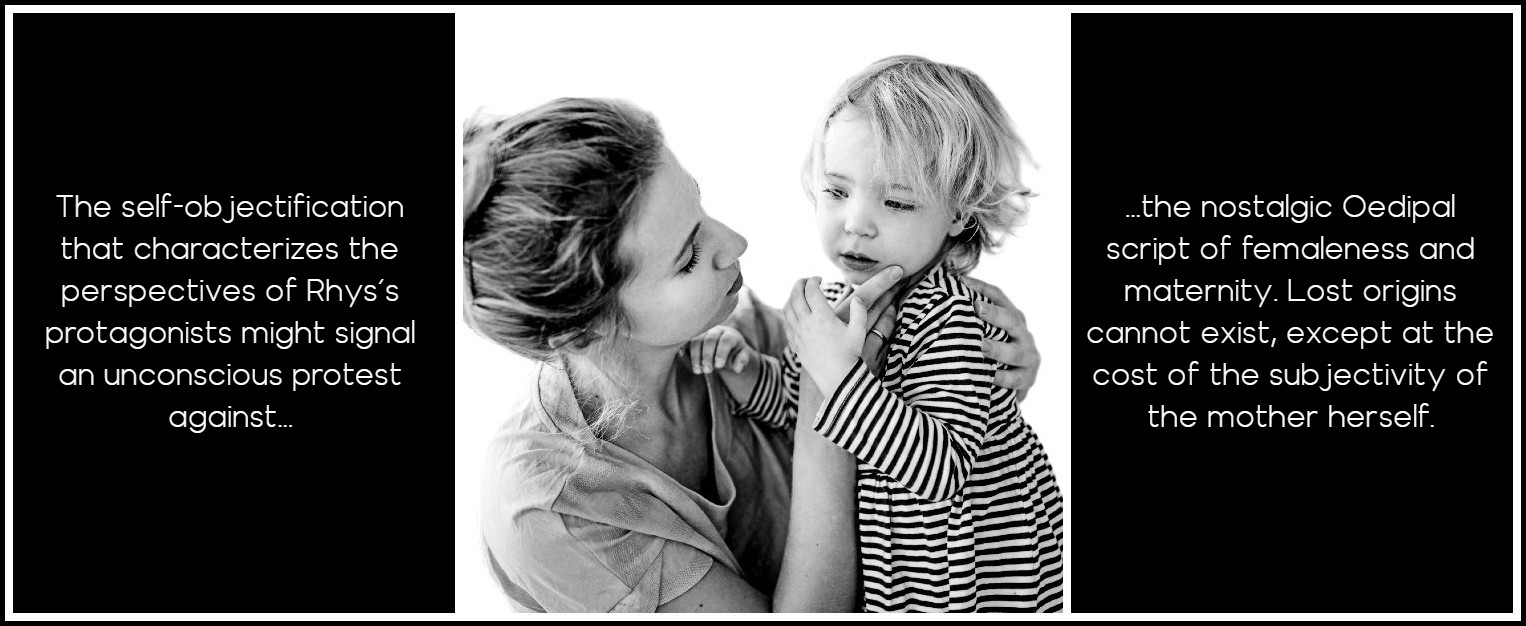
Photo: Getty Images for Unsplash
This observation is not merely prosaic, but implies the gaps between the silent, undifferentiated mother of Oedipally-driven melancholic fantasy, and the mother as the discrete subject, who experiences, desires and signifies without her infant. The latter mother is firmly repressed by the nostalgic fantasy of returning to one’s lost origins, since, as Sprengnether points out, the idea of the mother as the locus of ‘unity and fulfilment’ implies the exclusion of distinct maternal agency and signification. Two of Rhys’s novels, After Leaving Mr Mackenzie and Good Morning Midnight, portray childless mothers. While neither of these women identify primarily as bereaved mothers, both characters blame themselves for the loss of their infants. As such, these protagonists implicitly identify with the excoriated image of the wicked or murderous mother because, I would suggest, they have failed to die along with the child. There is a corresponding struggle and guilt whenever these mothers without children attempt to signify or represent themselves. Moreover, the story of the child’s death (and, implicitly, the mother’s survival) is culturally refused. Simply put, nobody wants to hear the story of Julia’s and Sasha’s child loss.
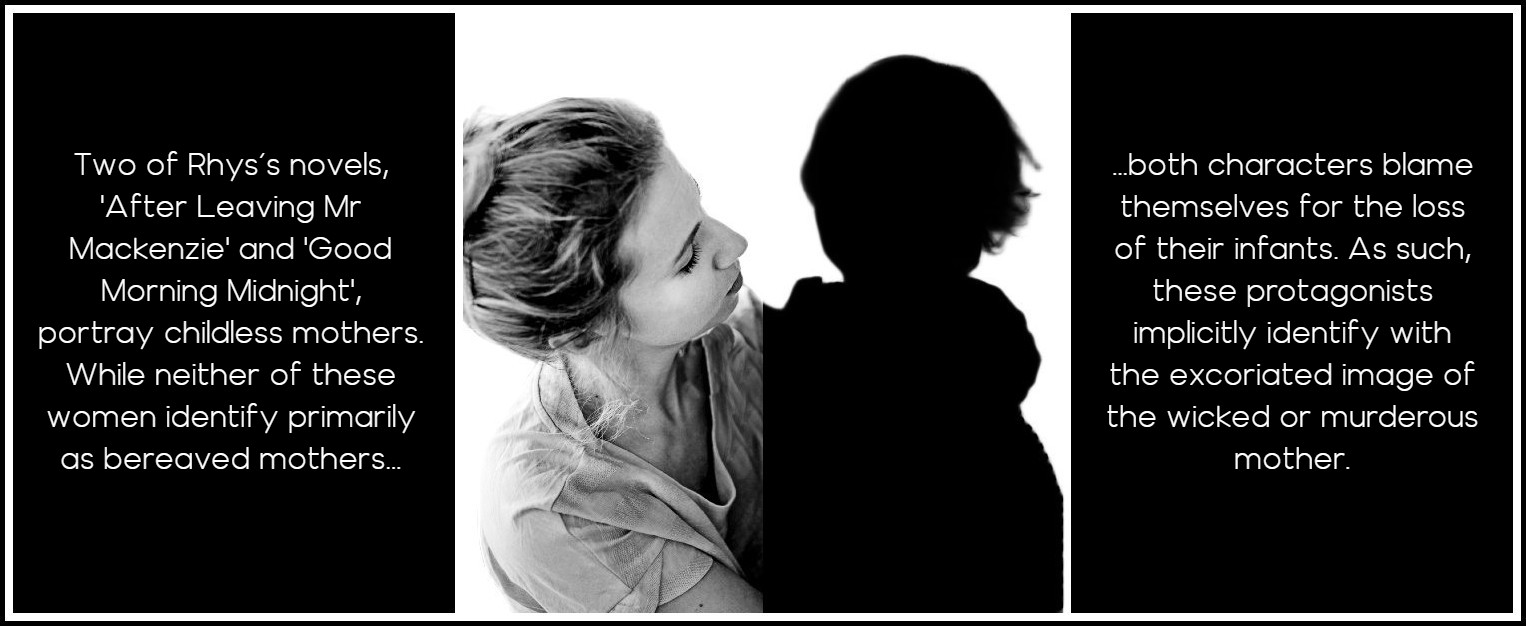
Photo: Getty Images for Unsplash
Furthermore, feminine identity in all of Rhys’s novels is complicated by nostalgic desire for the mother, who is always absent, inaccessible or (as in Julia’s case) infirm to the extent of apparent insentience. One needs to ask what the consequences are, for women, both mothers and non-mothers, of the Oedipal narrative of original mother-infant fusion, in which, as Sprengnether argues, the possibility of even minimal maternal autonomy is disavowed. Unavoidably, it seems, Rhys’s women identify with this undifferentiated, barely-signifying original mother, even as they express desire for her by identifying themselves as prominently inconsolable, distinct and in a sense ‘elite’ melancholics. The result of this contradiction, which I would suggest does not trouble masculine melancholic identification to the same extent, is speechlessness, inertia and implosive self-objectification—all classically depressive symptoms which could be interpreted as logical, rather than pathological, manifestations of the female subject’s role in the patriarchal narrative of maternal objecthood.
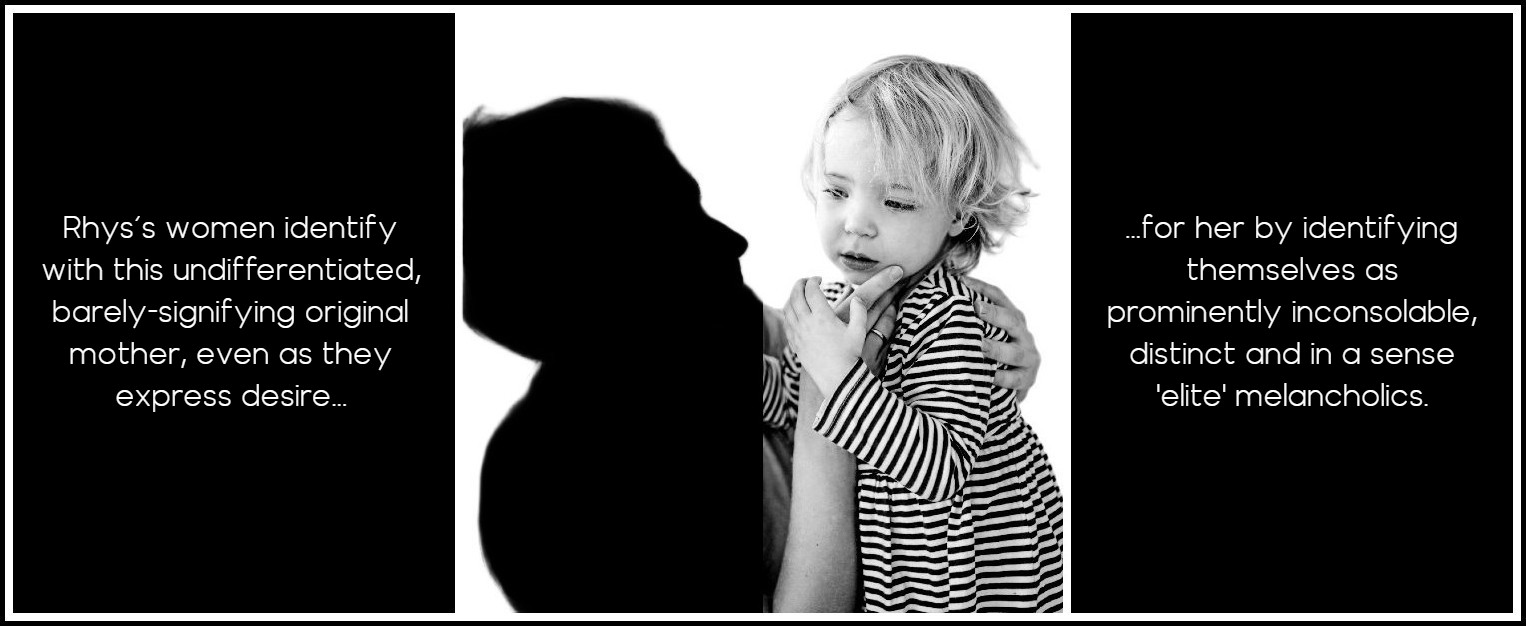
Photo: Getty Images for Unsplash
V. THE LOST TIME
As Greg Forter sums up, recent mourning theory accepts the idea that ‘a subject who is constituted by alienation into language is one that is ineradicably melancholy’.1 Susan Stewart foregrounds the similarly insurmountable alienation apparent in nostalgic desire: Nostalgia is a sadness without object, a sadness which creates a longing that is inauthentic because it does not partake in lived experience. Rather, it remains behind and before that experience. Nostalgia, like any form of narrative, is always ideological: the past it seeks has never existed except as narrative, and hence, always absent, that past continually threatens to reproduce itself as a felt lack.2 Given my foregoing synopsis of the melancholic’s fundamentally regressive, phantasmic desires, it might seem (in light of Stewart’s ascription of a near-identical problem to nostalgia) that the distinction between melancholia and nostalgia is minimal, If we situate melancholia as a long-celebrated cultural identity as well as a psychic affliction, this proximity seems even more pressing. As both Kristeva and Schiesari observe, the Western imagination has been significantly influenced by formalized nostalgia and melancholia in artistic practice.3 Schiesari writes: The ‘grievous’ suffering of the melancholic artist is a gendered one, an eroticized nostalgia that recuperates loss in the name of an imaginary unity and that also gives to the melancholic man a privileged position within literary, philosophical and artistic canons.4
1 – Greg Forter, ‘Against Melancholia: Contemporary Mourning Theory, Fitzgerald’s The Great Gatsby, and the Politics of Unfinished Grief,’ Differences: a Journal of Feminist Cultural Studies, 14: 2 (2005) 136
2 – Susan Stewart, On Longing: Narratives of the Miniature, the Gigantic, the Souvenir, the Collection (Baltimore: Johns Hopkins University Press, 1984) 23
3 – In Black Sun, Kristeva situates Holbein, Gérard de Nerval, Dostoevsky and Marguerite Duras as melancholic artists, devoting a chapter to each. Speaking more generally of melancholic artistry, she suggests that ‘art seems to point to a few devices that bypass complacency and, without simply turning mourning into mania, secure for the artist and the connoisseur a sublimatory hold over the Lost Thing’. (p. 97)
4 – Juliana Schiesari, Julian Schiesari, The Gendering of Melancholia: Feminism, Psychoanalysis and the Symbolics of Loss in Renaissance Literature (Ithaca: Cornell University Press, 1992) 11

Vasily Perov, Portrait of Feodor Dostoyevsky, 1872
Schiesari appropriately contests Kristeva’s valorization of such melancholic artistry in Black Sun. Kristeva discerns a violent misogyny in the supposedly cathartic stories of pain and blame rehearsed in psychotherapy, or iterated in ‘outlets’ such as art and literature, but fails to take issue with these worrying ‘counter-depressants,’ to use her own term. Adopting the persona of a melancholic artist or analysand, Kristeva contemplates the mother: I make of Her an image of Death so as not to be shattered through the hatred I bear against myself when I identify with Her. The feminine as image of death is an imaginary safety catch for the matricidal drive that, without such a representation, would pulverise me into melancholia. It is She who is death-bearing, therefore I do not kill myself in order to kill her but I attack her, harass her, represent her. What is this unfortunate mother ‘guilty’ of? What has she done to deserve this cultural and representational wrath? Quite simply, she has betrayed the authentic past, to which, as Kristeva comments, the melancholic remains riveted: Regressing to the paradise or inferno of an unsurpassable experience, melancholy persons manifest a strange memory: everything has gone by, they seem to say, but I am faithful to those bygone days, I am nailed down to them, no revolution is possible, there is no future.

Photo: Edin Hrnjić, Unsplash
Eric Santner suggests that the disavowal of such nostalgic fixation on the cultural level is an urgent focus for post-structuralist interrogation: The appeal in postmodern theoretical discourse to notions of shattering, rupture, mutilation, fragmentation, to images of fissures, wounds, rifts, gaps, and abysses is familiar enough. These discourses, primarily poststructuralist in inspiration, appear committed to the vigilant and radical critique of what are taken to be the narcissisms and nostalgias central to the project of modernity. These poststructuralist discourses propose a kind of perpetual leave-taking from fantasies of plenitude, purity, centrality, totality, unity and mastery as one disabused of notions of roots and rootedness.1 For Santner, the political danger of the melancholic-nostalgic fantasy of lost origins resides in its inherently violent, other-denying narcissism. Both nostalgics and melancholics insist upon seamless, unambiguous narratives and perfect dyadic identifications. Notwithstanding the political violence and practices of dehumanization enabled by such simplistic cultural narratives, nostalgic fantasy precludes, rather than invokes, an inhabitable, dignified identity. Santner writes: A mature self could never really develop in utopia. For the human self constitutes itself precisely by relinquishing its narcissistic position and mournfully, and perhaps even playfully, assuming its place in an expanded field of relations in which ‘I’ and ‘you,’ ‘here’ and ‘there,’ ‘now’ and ‘then’ signifiers and signifieds, have boundaries, that is, are discontinuous. It is this passage from a realm of continuity to one of contiguities that signals the advent of the uncanny—the unheimlich—in human experience. The more primitive labour of mourning is the integration of the unheimlich into the first person.
1 – Eric Santner, Stranded Objects: Mourning, Memory and Film in Postwar Germany (Ithaca: Cornell University Press, 1992) 7-8
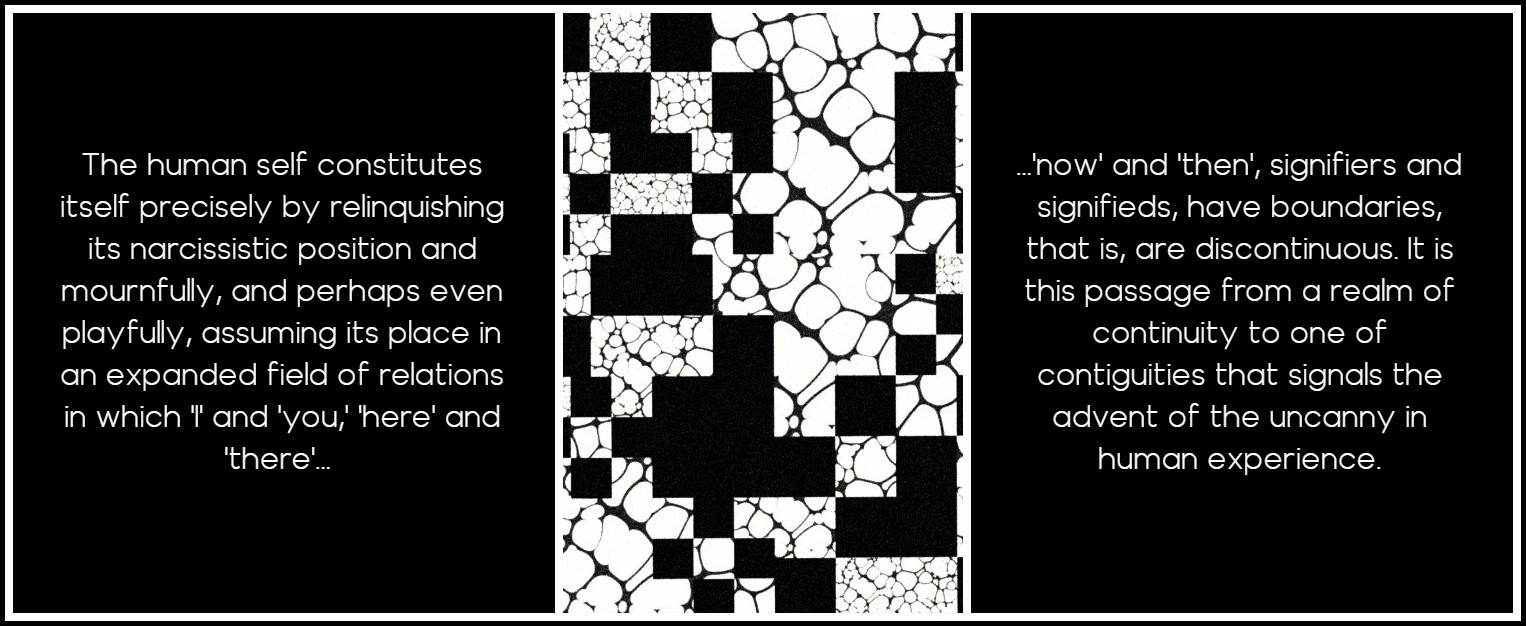
Photo: Allison Saeng, Unsplash
Elsewhere in his book, Santner explicitly identifies nostalgia as a defence against a social and political other experienced as unheimlich. This term is generally translated in English as ‘uncanny,’ but its precise German meaning is ‘unhomely,’ and this is the sense in which Santner generally uses it, to connote that which seems out of place in the subject’s home, be this a physical home (‘homeland,’ for example) or the phantasmic psychic ‘home’ of nostalgic fantasy. This melancholic-nostalgic quest for lost time, the most grandiose and intractable of all depressive grievances, expresses itself particularly in the conflation of mother with utopia. In particular, Rhys explores rhetorical linking of the lost mother with the lost place in Voyage in the Dark and Wide Sargasso Sea. Superficially, Antoinette and Anna both miss their ‘real’ homeland. This authentic place of origin is not so much their West Indian homeland (from which they have indeed been cruelly displaced), but rather the ‘home’ of the Western melancholic imagination, a utopia betrayed by the (m)other’s withdrawal of dyadic gaze and interaction.
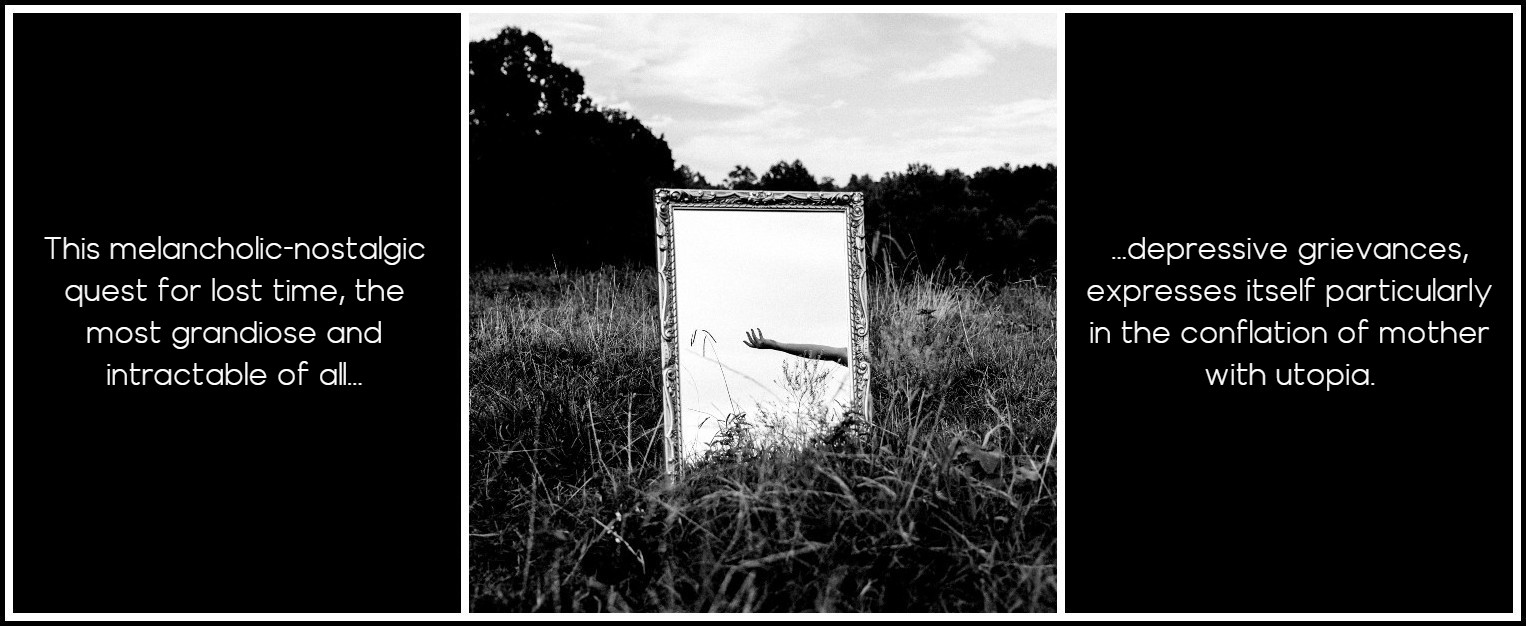
Photo: Chase Kennedy, Unsplash
VI. RHYS AND MELANCHOLIC WOMEN
The melancholic identifications of Rhys’s women are not always ‘innocent,’ or innocuous, but nevertheless my position with respect to Rhys’s representation of women’s loss and suffering is distinct from those readings which situate these protagonists as self-indulgent victims, complicit with their own oppression. This distinction might be delineated as such: I contend that Rhys’s protagonists sometimes resort to a dominant masculinist tradition of melancholia, and indeed these characters sometimes misappropriate marginal discourses of loss and alienation on their own behalf. However, it is my argument that Rhys’s work undertakes the difficult task of representing the suffering of women who inhabit a cultural place in between obvious empowerment and overt disenfranchisement and ‘otherness’. As such, these novels should be seen as a credible act of feminist writing, particularly in today’s critical and theoretical context, which rightfully seeks to recognize and engage with the plurality and complexity of identity.

Borghild Røed Lærum, Self-Portrait with Blue Anemone, 1904
Furthermore, Rhys’s interest in the intransigently melancholic woman is more transgressive than a comfortable narrative of recovery, simply because, as Schiesari emphasises, public and vehement displays of rage or sadness on the part of women are traditionally trivialized, restricted to narrow contexts, or altogether prohibited. Schiesari writes: A prestigious melancholia seems persistently denied to women, whose association with loss or grief is expressed by unflattering allusions to widow’s weeds, inarticulate weeping, or other signs of ritualistic (but intellectually and artistically unaccredited) mourning. A woman’s lament, grievance, or suffering is seen as a quotidian event whose collective force does not bear the same weight of ‘seriousness’ as a man’s grief. Although Schiesari is chiefly interested in the melancholic literature of the Renaissance, her engaging thesis concerning the cultural devaluation of women’s melancholic speech often resonates with Rhys’s modernist depiction of a feminine struggle to articulate anguish, disappointment and injustice. In Quartet, for instance, a conversation between Marya Zelli and her sexual rival Lois Heidler unequivocally suggests that indifference to female pain (and, correspondingly, the legitimizing of masculine suffering) is to be expected in the negotiation of heterosexual desire. When Marya tells Lois that sharing a man (Heidler) is unbearable and she ‘must go off,’ Lois points out that Heidler ‘wants things badly when he does want them. He’s a whole hogger.’ The text continues: ‘So am I,’ Marya told her. ‘That’s just why I must go off.’ The other made an impatient and expressive gesture, as if to say, ‘Do you suppose that I care what you are, or think or feel? I’m talking about the man, the male, the important person, the only person who matters.’

Agda Holst, Self-Portrait, 1925
Marya highlights the difference between herself and Lois as suffering, jealous women when she tells her rival, ‘I might come into the room and make a hell of a scene, but I’d never listen at the door, because I’ve not got patience enough’. But Lois has already learned that such rebellious scenes, when made by women, are never rewarded. She thinks to herself that ‘I’ve always let him alone and given him what he wanted and it’s never failed me.’ She tells Marya that ‘it’s fatal making a fuss’. This phrase of Lois’s, ‘making a fuss,’ devalues both her own and Marya’s suffering, situating their pain, as Schiesari says, as ‘quotidian’ and unworthy of mention. The male-privileging sexual culture that Rhys depicts in Quartet is one in which women earn and maintain a sham respect from men by suppressing, or at least minimizing, their own emotions, and accommodating male demands regardless of the cost to themselves: Lois didn’t analyse; she didn’t react violently; she didn’t go in for absurd generosities or pities. Her motto was: ‘I don’t think women ought to make nuisances of themselves. I don’t make a nuisance of myself, I grin and bear it, and I think that other women ought to grin and bear it, too.’ Violent feminine expressions of emotion or desire have no place in this gender etiquette. They are also liable to be punished: when Rhys’s women announce their desire or pain—that is, when they ‘make a fuss’—they are deemed to be insane, sexually suspect and sometimes racially ‘degenerate’.

Helene Schjerfbeck, Self-Portrait, 1885
These textual examples in mind, I suggest that Rhys’s work, for all the abasement of its protagonists and the pessimism of its politics, has fundamental feminist import in that, as Howells puts it, Rhys takes up ‘the challenge of constructing a female speaking subjectivity for her heroines.’1 This is indeed a remarkable challenge, not only because of the thoroughgoing cultural refusal of the suffering woman’s speech, but also because Rhys’s protagonists are hardly heroic in the usual sense. For one, they are not women with whom feminist readers can happily identify. At best, they are readily objectified tragic figures; at worst, they veer between narcissistic self-absorption and cringing servility towards those who exploit them. If there is little to admire in Rhys’s characters in terms of feminist aspiration, there is even less to like from a conventional or conservative moral perspective, in which good, wise women stoically, silently accept injustice.
1 – Coral Ann Howells, Jean Rhys (Hemel Hempstead: Harvester Wheatsheaf, 1991) 6
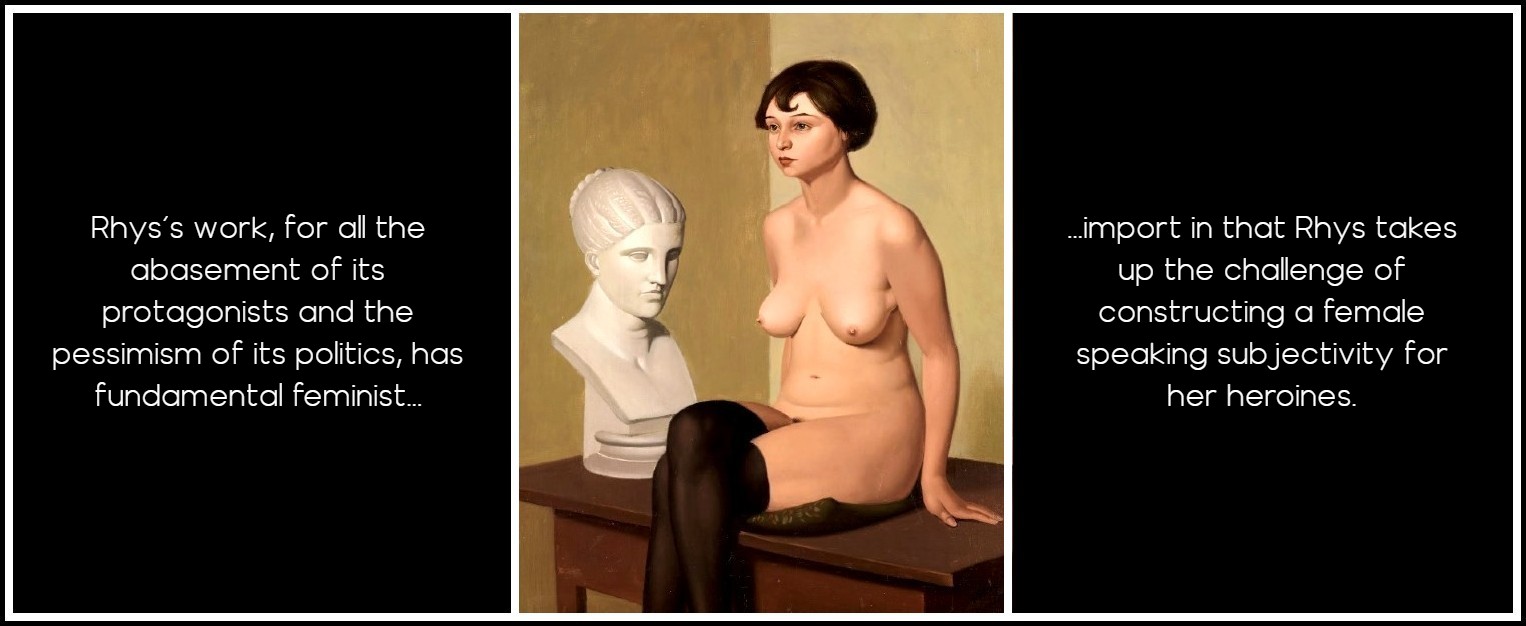
Georg Scholz, Female Nude and a Plaster Head, 1927
Moreover, the Rhysian protagonist’s appropriation of melancholic identity and speech, while transgressive in that melancholia is traditionally deployed on behalf of the masculine subject, does not ‘constructively’ confront social, cultural and gender prejudices. The seditious gestures of Rhys’s major characters are inevitably self-damaging or even suicidal. Indeed, the self-destructiveness of the Rhysian protagonist in her act of rebellion might well be connected with her effort to assume the melancholic identity, for this identity does not, culturally speaking, belong to her. The desire to articulate feminine suffering informs all of Rhys’s narratives, but this desire sits uneasily with a gendered melancholic discourse which implicitly prohibits the representation of women’s pain (indeed, Schiesari goes so far as to suggest that melancholic discourse traditionally appropriates feminine pain on behalf of the male). This incongruity between the gendered modalities of melancholic speech and the desire of Rhys’s characters to articulate (or at least privately claim) their pain perhaps accounts for the female self-destructiveness that is so apparent in these narratives. To put it simply, these women consume, rather than recuperate, their identities in acts of unconsciously misogynist melancholic speech and identification.
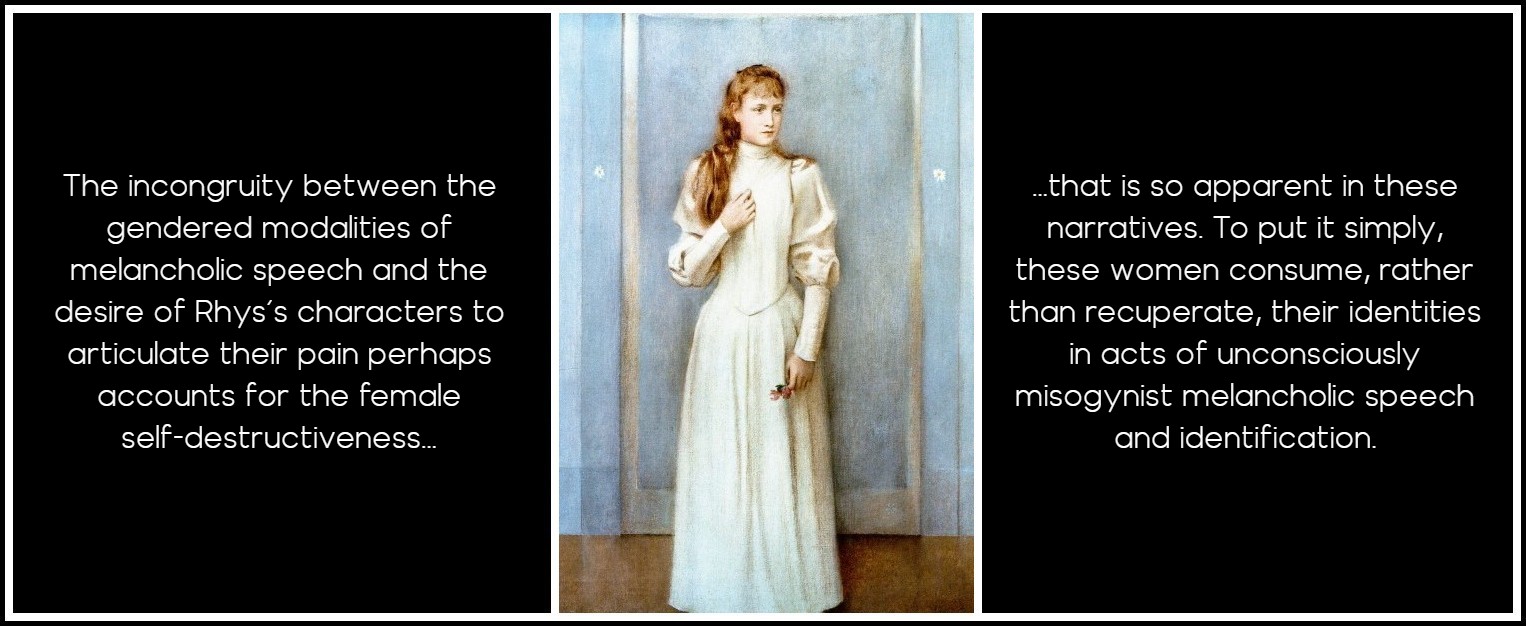
Fernand Khnopff, Portrait posthume de Marguerite Landuyt, 1896
Furthermore, the apparent futility of the melancholic sedition in these novels guarantees that Rhys’s ethnically and socially marginal protagonists will not present us with attractive, emancipatory role models. Yet Rhys is committed to representing their desires and frustrations, even their flaws, without apology or condemnation, and with as much honesty as possible, From the point of view of this reader at least, this is a significant contribution made by Rhys to the modernist inscription of the ‘feminine condition,’ or, more appropriately for Rhys, pluralistic experiences of femininity. I will conclude with reference to Eric Santner, who suggests that ‘mourning, if it is not to become entrapped in inertia, if it is to become integrated into a history, must be witnessed’.1 In the spirit of Santner’s humane observation, I suggest that whatever the problems attending the Rhysian protagonist’s mode of speech and self-construction, or the lack thereof, Rhys’s writerly enterprise demands our respect and empathy in that she strives to facilitate a witnessing of the suffering of marginalized women. Furthermore, Rhys actually connects the easily despised ‘inertia’ of these women with the thoroughgoing social refusal of their suffering: surely a constructive feminist insight.
1 – 1 – Eric Santner, Stranded Objects: Mourning, Memory and Film in Postwar Germany (Ithaca: Cornell University Press, 1992) 28

Stanley Spencer, Portrait in a Garden (Patricia Preece), 1936
MARA, MARIETTA: A LOVE STORY IN 77 BEDROOMS – READ THE FIRST CHAPTER
A literary novel by Richard Jonathan
RICHARD JONATHAN, ‘MARA, MARIETTA: A LOVE STORY IN 77 BEDROOMS’ — READ THE FIRST CHAPTER
AMAZON & APPLE BOOKS
RICHARD JONATHAN, ‘MARA, MARIETTA: A LOVE STORY IN 77 BEDROOMS’ | AMAZON PAPERBACK OR KINDLE
RICHARD JONATHAN, ‘MARA, MARIETTA: A LOVE STORY IN 77 BEDROOMS’ | APPLE iBOOK
MARA, MARIETTA: A LOVE STORY IN 77 BEDROOMS
A literary novel by Richard Jonathan
RELATED POSTS IN THE MARA MARIETTA CULTURE BLOG
CLICK ON THE IMAGE TO GO TO THE PAGE
By Richard Jonathan | © Mara Marietta Culture Blog, 2025 | All rights reserved




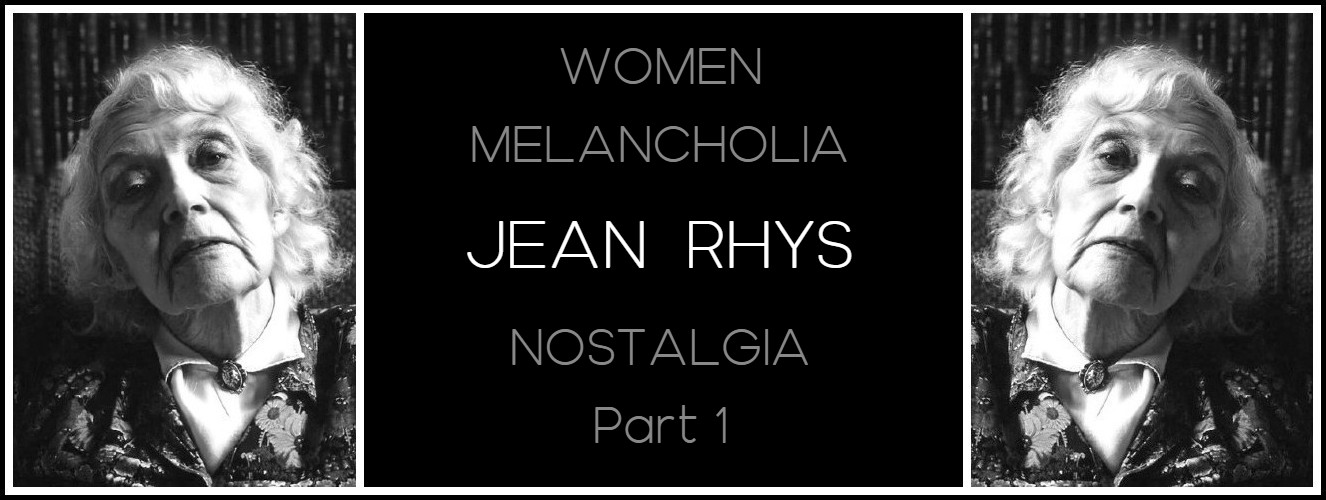
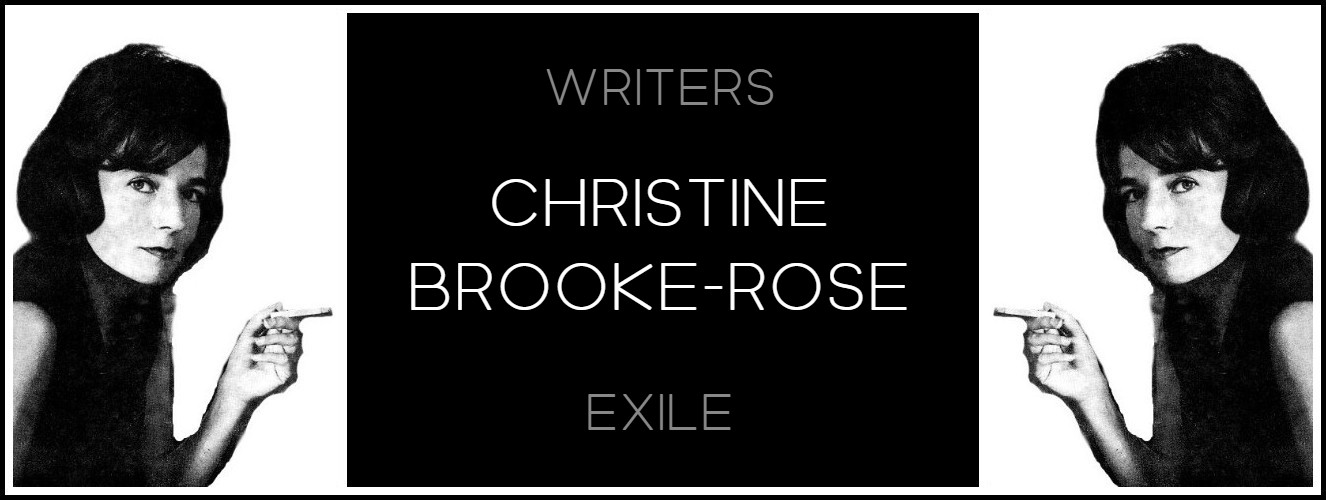


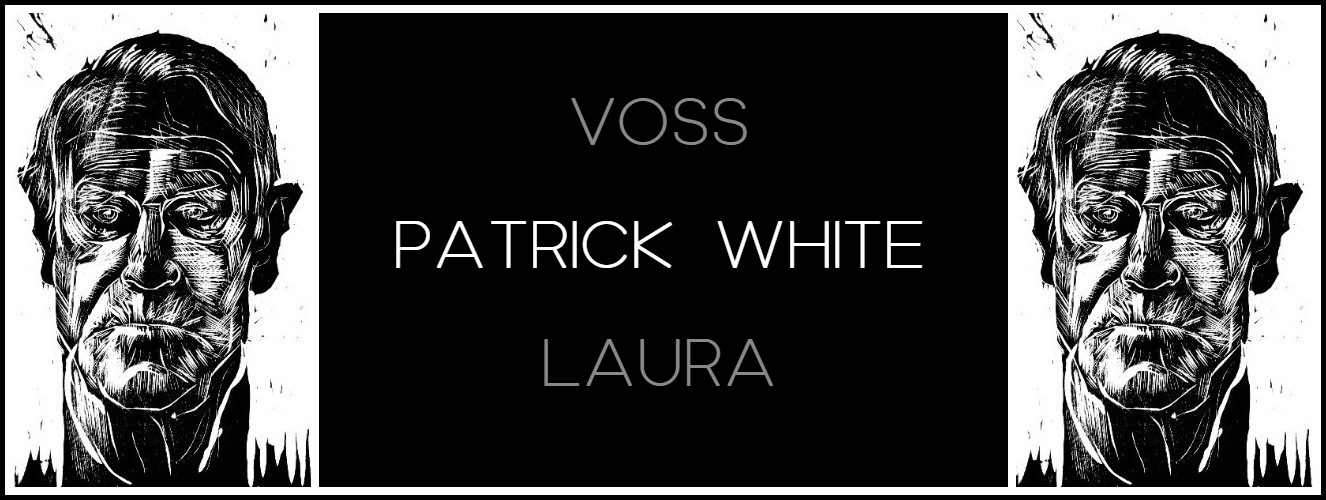
Comments